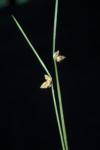Latin name
Schoenoplectus juncoides (Roxb.) Palla
Family
Cyperaceae
Common name(s)
Sedge
Synonym(s)
Scirpus juncoides Roxb. (basionym).
Geographical distribution
Asia: Japan and Korea.
Southeast and Southeast Asia: Bangladesh, Cambodia, India, Indonesia, Lao PDR, Malaysia, Myanmar, Nepal, Pakistan, Philippines, Sri Lanka, Thailand, and Vietnam.
Rest of the world: Australia, Ecuador, Fiji, Madagascar, and United States (Hawaii).
Morphology
A tufted, erect, strongly tillering and slender annual or perennial, up to 60—cm—tall.
Stem: erect, smooth, rounded or slightly angular, ribbed and extended 2—10—cm beyond the inflorescence.
Leaf: reduced to 2—3 membranous leaf, truncated at top sheath, often with a small rudimentary blade.
Inflorescence: 2—5 sessile spikelets, ovoid to oblong, 1—cm or less long, greenish brown or straw-colored to brownish.
Fruit: a shiny black nut, strongly compressed, obovoid and about 2—mm—long.
Biology and ecology
Found in lowland rice, shallow ponds, streams, and drains.
Emerges directly from seeds in puddled rice fields; in swampy areas where tillage is minimal, seedlings emerge from vegetative buds. Seed germination increases under anaerobic conditions.
In competition with rice, about 1,500 seeds are produced per plant.
Agricultural importance
Can be a major weed in lowland rice fields.
Management
Cultural: dry rotovation and wet puddling can reduce populations.
Chemical: Pretilachlor, butachlor, thiobencarb, and sulfonylureas are reported to be effective in rice.
Selected references
Azmi M, Bakar B, Mansor M. 1993. Weed communities in principal rice-growing areas in penisular Malaysia. MARDI Report 165:1-16.Kataoka T, Kim SY. 1978. Emergence depth of seeds of several weeds. Weed Res. 23(1): 9-12.Kern JH. 1974. Cyperacea. Flora Malesiana Ser. 1 7(3):435-753.Moody K. 1989. Weeds reported in rice in South and Southeast Asia. Manila (Philippines): International Rice Research Institute. 442 p.Soerjani M, Kostermans AJGH, Tjitrosoepomo G. 1987. Weeds of rice in Indonesia. Jakarta (Indonesia): Balai Pustaka. 716 p.Watanabe H. 2000. Biological aspects of Scirpus juncoides in relation to management in rice fields of Japan. Proc. international workshop on biology and management of noxious weeds for sustainable and labor saving rice production. Tsukuba, Ibaraki, (Japan): National Agriculture Research Center, Ministry of Agriculture Forestry and Fisheries. pp. 57-63.
Contributors
JLA Catindig, RT Lubigan, and DE Johnson
